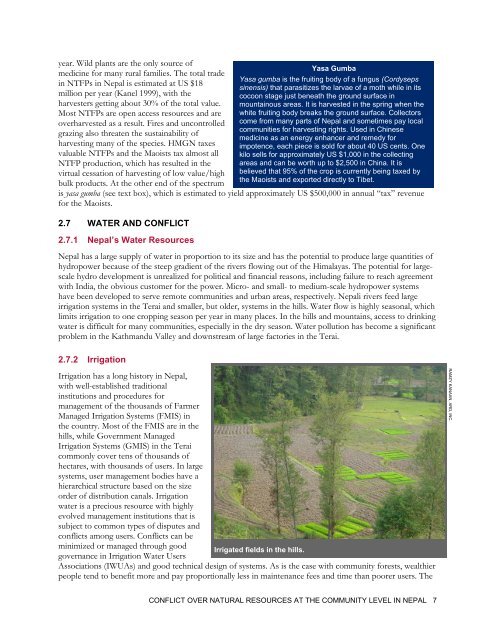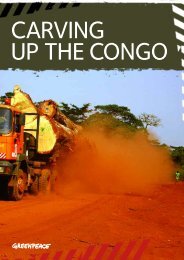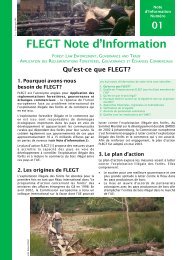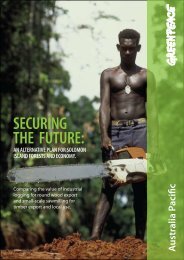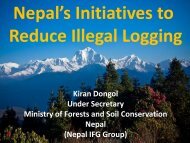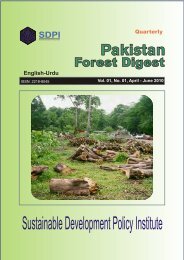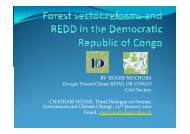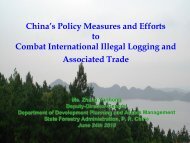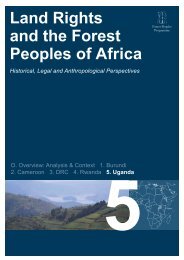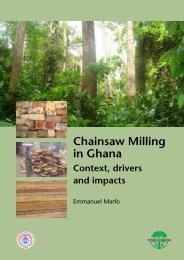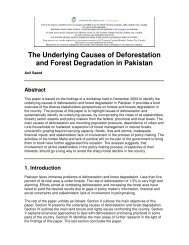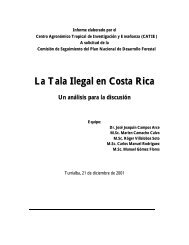conflict over natural resources at the community level in nepal
conflict over natural resources at the community level in nepal
conflict over natural resources at the community level in nepal
Create successful ePaper yourself
Turn your PDF publications into a flip-book with our unique Google optimized e-Paper software.
year. Wild plants are <strong>the</strong> only source ofmedic<strong>in</strong>e for many rural families. The total trade<strong>in</strong> NTFPs <strong>in</strong> Nepal is estim<strong>at</strong>ed <strong>at</strong> US $18million per year (Kanel 1999), with <strong>the</strong>harvesters gett<strong>in</strong>g about 30% of <strong>the</strong> total value.Most NTFPs are open access <strong>resources</strong> and are<strong>over</strong>harvested as a result. Fires and uncontrolledgraz<strong>in</strong>g also thre<strong>at</strong>en <strong>the</strong> susta<strong>in</strong>ability ofharvest<strong>in</strong>g many of <strong>the</strong> species. HMGN taxesvaluable NTFPs and <strong>the</strong> Maoists tax almost allNTFP production, which has resulted <strong>in</strong> <strong>the</strong>virtual cess<strong>at</strong>ion of harvest<strong>in</strong>g of low value/highbulk products. At <strong>the</strong> o<strong>the</strong>r end of <strong>the</strong> spectrumYasa GumbaYasa gumba is <strong>the</strong> fruit<strong>in</strong>g body of a fungus (Cordysepss<strong>in</strong>ensis) th<strong>at</strong> parasitizes <strong>the</strong> larvae of a moth while <strong>in</strong> itscocoon stage just bene<strong>at</strong>h <strong>the</strong> ground surface <strong>in</strong>mounta<strong>in</strong>ous areas. It is harvested <strong>in</strong> <strong>the</strong> spr<strong>in</strong>g when <strong>the</strong>white fruit<strong>in</strong>g body breaks <strong>the</strong> ground surface. Collectorscome from many parts of Nepal and sometimes pay localcommunities for harvest<strong>in</strong>g rights. Used <strong>in</strong> Ch<strong>in</strong>esemedic<strong>in</strong>e as an energy enhancer and remedy forimpotence, each piece is sold for about 40 US cents. Onekilo sells for approxim<strong>at</strong>ely US $1,000 <strong>in</strong> <strong>the</strong> collect<strong>in</strong>gareas and can be worth up to $2,500 <strong>in</strong> Ch<strong>in</strong>a. It isbelieved th<strong>at</strong> 95% of <strong>the</strong> crop is currently be<strong>in</strong>g taxed by<strong>the</strong> Maoists and exported directly to Tibet.is yasa gumba (see text box), which is estim<strong>at</strong>ed to yield approxim<strong>at</strong>ely US $500,000 <strong>in</strong> annual “tax” revenuefor <strong>the</strong> Maoists.2.7 WATER AND CONFLICT2.7.1 Nepal’s W<strong>at</strong>er ResourcesNepal has a large supply of w<strong>at</strong>er <strong>in</strong> proportion to its size and has <strong>the</strong> potential to produce large quantities ofhydropower because of <strong>the</strong> steep gradient of <strong>the</strong> rivers flow<strong>in</strong>g out of <strong>the</strong> Himalayas. The potential for largescalehydro development is unrealized for political and f<strong>in</strong>ancial reasons, <strong>in</strong>clud<strong>in</strong>g failure to reach agreementwith India, <strong>the</strong> obvious customer for <strong>the</strong> power. Micro- and small- to medium-scale hydropower systemshave been developed to serve remote communities and urban areas, respectively. Nepali rivers feed largeirrig<strong>at</strong>ion systems <strong>in</strong> <strong>the</strong> Terai and smaller, but older, systems <strong>in</strong> <strong>the</strong> hills. W<strong>at</strong>er flow is highly seasonal, whichlimits irrig<strong>at</strong>ion to one cropp<strong>in</strong>g season per year <strong>in</strong> many places. In <strong>the</strong> hills and mounta<strong>in</strong>s, access to dr<strong>in</strong>k<strong>in</strong>gw<strong>at</strong>er is difficult for many communities, especially <strong>in</strong> <strong>the</strong> dry season. W<strong>at</strong>er pollution has become a significantproblem <strong>in</strong> <strong>the</strong> K<strong>at</strong>hmandu Valley and downstream of large factories <strong>in</strong> <strong>the</strong> Terai.2.7.2 Irrig<strong>at</strong>ionIrrig<strong>at</strong>ion has a long history <strong>in</strong> Nepal,with well-established traditional<strong>in</strong>stitutions and procedures formanagement of <strong>the</strong> thousands of FarmerManaged Irrig<strong>at</strong>ion Systems (FMIS) <strong>in</strong><strong>the</strong> country. Most of <strong>the</strong> FMIS are <strong>in</strong> <strong>the</strong>hills, while G<strong>over</strong>nment ManagedIrrig<strong>at</strong>ion Systems (GMIS) <strong>in</strong> <strong>the</strong> Teraicommonly c<strong>over</strong> tens of thousands ofhectares, with thousands of users. In largesystems, user management bodies have ahierarchical structure based on <strong>the</strong> sizeorder of distribution canals. Irrig<strong>at</strong>ionw<strong>at</strong>er is a precious resource with highlyevolved management <strong>in</strong>stitutions th<strong>at</strong> issubject to common types of disputes and<strong>conflict</strong>s among users. Conflicts can bem<strong>in</strong>imized or managed through goodIrrig<strong>at</strong>ed fields <strong>in</strong> <strong>the</strong> hills.g<strong>over</strong>nance <strong>in</strong> Irrig<strong>at</strong>ion W<strong>at</strong>er UsersAssoci<strong>at</strong>ions (IWUAs) and good technical design of systems. As is <strong>the</strong> case with <strong>community</strong> forests, wealthierpeople tend to benefit more and pay proportionally less <strong>in</strong> ma<strong>in</strong>tenance fees and time than poorer users. TheRAMZY KANAAN, ARD, INC.CONFLICT OVER NATURAL RESOURCES AT THE COMMUNITY LEVEL IN NEPAL 7


